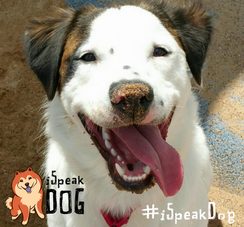Ben watched the loose-leash walking video on the Leash Issues page, and found techniques to help Ranger. He had Ranger do a sit-stay when dogs and joggers approached, and fed him yummy treats that Ranger doesn't usually get to eat.
Ben took Ranger to a 5k race on Saturday, and they sat on the curb while runners passed by. "He was actually lying down beside me, watching them all run by, and it was pretty amazing," Ben says. Any time Ranger looked into Ben's eyes rather than looking at runners, Ben gave Ranger a piece of chicken. "I see him look at me with more confidence and trust. It's a great feeling," Ben says. "I want to be the person my dog looks to and can count on, not the person he fears because I'm frustrated. I have more work to do with myself, but the three steps and body language webinar have helped me tremendously." We are so thrilled that Ben and Ranger are already enjoying a happier life together! How has iSpeakDog helped you and your pooch? Do you have a story to share? We'd love to hear from you.
0 Comments
Your comment will be posted after it is approved.
Leave a Reply. |


